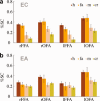Internal representations for face detection: an application of noise-based image classification to BOLD responses
- PMID: 22711230
- PMCID: PMC4204487
- DOI: 10.1002/hbm.22128
Internal representations for face detection: an application of noise-based image classification to BOLD responses
Abstract
What basic visual structures underlie human face detection and how can we extract such structures directly from the amplitude of neural responses elicited by face processing? Here, we address these issues by investigating an extension of noise-based image classification to BOLD responses recorded in high-level visual areas. First, we assess the applicability of this classification method to such data and, second, we explore its results in connection with the neural processing of faces. To this end, we construct luminance templates from white noise fields based on the response of face-selective areas in the human ventral cortex. Using behaviorally and neurally-derived classification images, our results reveal a family of simple but robust image structures subserving face representation and detection. Thus, we confirm the role played by classical face selective regions in face detection and we help clarify the representational basis of this perceptual function. From a theory standpoint, our findings support the idea of simple but highly diagnostic neurally-coded features for face detection. At the same time, from a methodological perspective, our work demonstrates the ability of noise-based image classification in conjunction with fMRI to help uncover the structure of high-level perceptual representations.
Keywords: fMRI; face recognition; reverse correlation.
Copyright © 2012 Wiley Periodicals, Inc.
Figures








Similar articles
-
Spatiotemporal dynamics of similarity-based neural representations of facial identity.Proc Natl Acad Sci U S A. 2017 Jan 10;114(2):388-393. doi: 10.1073/pnas.1614763114. Epub 2016 Dec 27. Proc Natl Acad Sci U S A. 2017. PMID: 28028220 Free PMC article.
-
The fusiform face area subserves face perception, not generic within-category identification.Nat Neurosci. 2004 May;7(5):555-62. doi: 10.1038/nn1224. Epub 2004 Apr 11. Nat Neurosci. 2004. PMID: 15077112
-
Expectation and surprise determine neural population responses in the ventral visual stream.J Neurosci. 2010 Dec 8;30(49):16601-8. doi: 10.1523/JNEUROSCI.2770-10.2010. J Neurosci. 2010. PMID: 21147999 Free PMC article.
-
The effect of acquisition resolution on orientation decoding from V1 BOLD fMRI at 7T.Neuroimage. 2017 Mar 1;148:64-76. doi: 10.1016/j.neuroimage.2016.12.040. Epub 2017 Jan 4. Neuroimage. 2017. PMID: 28063973
-
Adaptation: from single cells to BOLD signals.Trends Neurosci. 2006 May;29(5):250-6. doi: 10.1016/j.tins.2006.02.008. Epub 2006 Mar 10. Trends Neurosci. 2006. PMID: 16529826 Review.
Cited by
-
Seeing Jesus in toast: neural and behavioral correlates of face pareidolia.Cortex. 2014 Apr;53:60-77. doi: 10.1016/j.cortex.2014.01.013. Epub 2014 Jan 31. Cortex. 2014. PMID: 24583223 Free PMC article.
-
The Face of Image Reconstruction: Progress, Pitfalls, Prospects.Trends Cogn Sci. 2020 Sep;24(9):747-759. doi: 10.1016/j.tics.2020.06.006. Epub 2020 Jul 13. Trends Cogn Sci. 2020. PMID: 32674958 Free PMC article. Review.
-
Detection of functional brain network reconfiguration during task-driven cognitive states.Neuroimage. 2016 Nov 15;142:198-210. doi: 10.1016/j.neuroimage.2016.05.078. Epub 2016 May 31. Neuroimage. 2016. PMID: 27261162 Free PMC article.
-
Unraveling other-race face perception with GAN-based image reconstruction.Behav Res Methods. 2025 Mar 14;57(4):115. doi: 10.3758/s13428-025-02636-z. Behav Res Methods. 2025. PMID: 40087201
-
Rapid and dynamic processing of face pareidolia in the human brain.Nat Commun. 2020 Sep 9;11(1):4518. doi: 10.1038/s41467-020-18325-8. Nat Commun. 2020. PMID: 32908146 Free PMC article.
References
-
- Abbey CK, Eckstein MP (2002): Classification image analysis: Estimation and statistical inference for two‐alternative forced‐choice experiments. J Vis 2:66–78. - PubMed
-
- Ahumada AJ (2002): Classification image weights and internal noise level estimation. J Vis 2:121–131. - PubMed
-
- Avidan G, Hasson U, Malach R, Behrmann M (2005): Detailed exploration of face‐related processing in congenital prosopagnosia. 2. Functional neuroimaging findings. J Cogn Neurosci 17:1150–1167. - PubMed
-
- Barlow HB (1961): Possible principles underlying the transformation of sensory messages In: Rosenblith W, editor.Sensory Communication. Cambridge, MA:MIT Press; pp217–234.
Publication types
MeSH terms
Substances
Grants and funding
LinkOut - more resources
Full Text Sources
Medical

